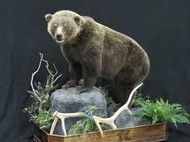Curious about Taxidermy?
Published by Sam Morey on Jul 25th 2018
The practice of preserving the skin of an animal after its death has been with us for thousands of years.In the 1800’s, after the term taxidermy had been officially coined, it became the primary method of displaying hunting trophies. Since then, taxidermy has gone through a few interesting phases.Today taxidermy exists in two major categories, taxidermy on smalls animals and taxidermy on large animals.
Small Animals
The smaller the animal, the more tedious the taxidermy process can be. With small animals like fish and birds, extra care needs to be taken to ensure the head or beak remains entirely intact. In fact, the toolkit for taxidermy on a small animal can often look like a tray of dental devices.
Large Animals
Taxidermy nowadays is most commonly done on large game animals. In the United States, this usually means bears, deer, and maybe the occasional big cat. While not as tedious as smaller animals, large animals do take longer to be completed. Some of the biggest animals like black bears could take months of work before they’re ready to go on display. Though if you’re doing the taxidermy yourself, you could always save a little time by purchasing a moldinstead of creating one yourself.
While bears and big cats are usually preserved in their entirety and mounted in a full-body, active position, with deer it’s often different. Since deer are commonly eaten after being hunted, and they’re not considered too rare of a catch, it’s usually just the deer’s head that gets mounted and not the body.
Taxidermy on Pets
In recent decades a new taxidermy trend has arisen: taxidermy on pets. While in the past taxidermy was reserved for wild animals and hunting trophies, nowadays an increasing number of people choose taxidermy as a way to immortalize their deceased family friends. Choosing a taxidermist with substantial skill is probably most important in this category of taxidermy. No one wants their loyal friends sent back to them looking like a taxidermy nightmare.
Silicone in Taxidermy
One vital but often overlooked tool for taxidermy is silicone. Nowadays the interior of a taxidermy project is often a mold, rather than the stuffing that was common in the past.These molds can be created with silicone. More often, however, silicone’s role in taxidermy is that of a sealant. Silicone sealant is often used to help hold the seams of a taxidermy animal together. Sealant is especially common in birds to keep their longer feathers attached and looking like they did in life.

